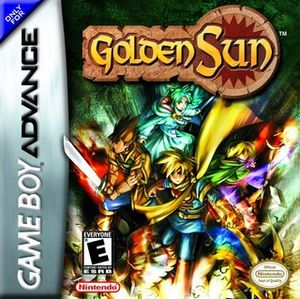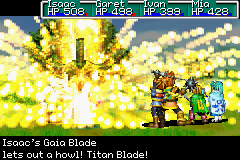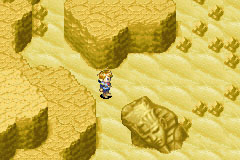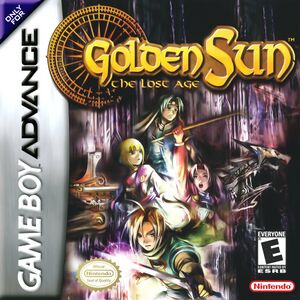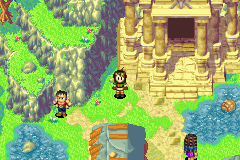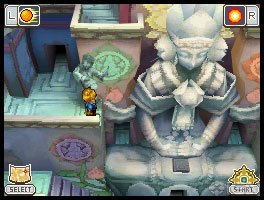Golden Sun series

The Golden Sun series is a series of video games created by Camelot Software Planning and published by Nintendo for various portable systems. At present, three games have been released, the most recent having been released in North America on November 29th, 2010. The series has also been represented via light cameo appearances in the Super Smash Bros. crossover fighting game series, and at least two sanctioned manga products have been released.
Golden Sun
- Main article: Golden Sun (game)
The first game, sometimes referred to by its Japanese subtitle "The Broken Seal" to differentiate it from The Lost Age, was released in Japan in August 2001, North America in November 2001, and Europe in February 2002. It focuses on the journey of Isaac, Garet, Ivan, and Mia in pursuit of a band of antagonists led by Saturos and Menardi. Saturos' group intends to unleash the sealed power of Alchemy into the world by using the four Elemental Stars to light the beacons atop the four Elemental Lighthouses situated across the world; Isaac's party is tasked by the Wise One, the mysterious guardian of the seal placed on Alchemy, to prevent this on the basis that Alchemy's power would spell potential cataclysm for the world if mankind were to abuse it. The world of Weyard is introduced to the player, but only a limited portion of it is explored; the majority of the plot progression takes places on the continent of Angara and the upper half of the neighboring continent of Gondowan to the south, and two of the four Lighthouses are visited over the course of the story.
The various basic concepts of the GBA series established in Golden Sun include exploring dungeons that are filled with random encounters as well as environmental and layout-based puzzles that obstruct the player's path, and the Psynergy system which is used both to solve puzzles and to serve as battle commands for various purposes in combat. In addition, the Character class system and Summoning mechanics are introduced, alongside the collectible Djinn which contribute to both mechanics. 7 Djinn of each element for a total of 28 Djinn are available to find and earn, ultimately providing players with up to 7 to be allocated to each of the four playable characters. 16 mono-element summon sequences - the ones inherently available to the party - are introduced as well.
Upon completing the game, a Clear Data file may be saved. By using a hidden "Send Data" option from Golden Sun's main menu, Clear Data can be used to transfer data from Golden Sun to The Lost Age. This can be achieved either by using two GBA systems and a Game Link Cable, or by using one of three different tiers of password which must be manually input into The Lost Age. The transfer sends over data about the player's party, including their names and Djinn, and unlocks some unique scenes and items in The Lost Age.
Golden Sun: The Lost Age
- Main article: Golden Sun: The Lost Age'
The Lost Age is a direct continuation of the first game; it released in Japan in June 2002, North America in April 2003, and Europe in September 2003. The game focuses on members and former captives of the original game's antagonistic party leading their own journey across the world of Weyard: Felix, Jenna, and Sheba are now playable characters, and they soon befriend a new ally named Piers and use his personal sailing ship to explore the oceans of the world and the many islands and continents surrounding the two continents featured in the first game. Felix leads the group toward their objective to complete Saturos and Menardi's goal to light the remaining Elemental Lighthouses and release Alchemy into the world; they are pursued by the heroes of the previous game, who intend to stop them. Felix must also contend with a new pair of warriors, Karst and Agatio, who are bent on seeking out Isaac to slay him in retaliation for his group's murder of Saturos and Menardi. Over the course of the story, Felix learns more about the nature of Alchemy; he ultimately convinces Isaac's party to join his cause, with the two groups joining forces to form a final traveling party of eight Adepts.
Many of the concepts brought back from Golden Sun are expanded upon with new material, and several new features are added as well. A much larger portion of Weyard can be explored - though none of the previous games areas are available - and the world is explored in a less linear order, requiring exploration by land as well as by sea with the newly added ship. The dungeons found throughout the world are larger on average, and many can be completed in variable order. There are four new playable characters, to which the four previous characters are eventually added to form a final party of 8 Adepts. There are 44 new Djinn, which when added up with the 28 Djinn the previous game's party may bring with them form a grand total of 72 Djinn; 18 for each element, with and 9 available to each character. More Djinn being available per-Adept allows class series to become stronger, sometimes granting stronger variants of Psynergy. Additionally, there are a few brand new class series, including three which are granted by unique equippable items that players can discover. There are thirteen new summon sequences that may be discovered throughout the game in the form of hidden, collectible Summon tablets, which varying amounts of two different elements of Djinn use, and include secondary effects in their attacks. Finally, much of the game's new gear comes about from a new, randomized item crafting system available in one particular town, making use of collectible forgeable materials as well as rusty items that need to be reforged.
The changes to gameplay brought about by transferring data from a completed save file from the previous game include primarily the inventory, statistics, and Djinn collections of the original game's party when they join Felix's party late in The Lost Age. Also, several bonus events may trigger based on what was achieved in the previous adventure, some of which yield unique equipment. The most important effect of this is that all 72 Djinn may be amassed; this allows for the most challenging bonus dungeon in the series, the Anemos Inner Sanctum, to be entered. The dungeon also contains the most powerful optional boss in the series, as well as the final two summon tablets, Charon and Iris.
Golden Sun: Dark Dawn
- Main article: Golden Sun: Dark Dawn'
First announced at E3 2009, released in Japan on October 28 2010, and released in North America and other regions from November to December, Golden Sun: Dark Dawn is the first installment of what has been described as the "main story", to which the Game Boy Advance duology are described as the "prologues". Set thirty years after the end of The Lost Age, the game focuses on the offspring of the previous games' heroes, led by Isaac's son, Matthew. His, Karis', and Tyrell's quest starts out as a search for a rare feather from the gigantic Mountain Roc - a quest handed down to them by Isaac as a rite of passage for them to take as Adepts. However, their journey quickly gets sidetracked as they find themselves entangled in a strange scheme authored by the ruler of the enigmatic, military country of Tuaparang, to whom the commanders Blados, Chalis, and a very familiar face are subservient. As they are joined by friends from a variety of cultural backgrounds - Rief, Amiti, Sveta, Eoleo, and Himi - Matthew's company revitalizes Alchemy-based machinery left behind by the ancients of an age long past, returning regions of Angara to the former glory of ancient civilizations previously believed extinct. But years of racial prejudice and military conflict between humanity and a recently-transformed clan of hybrid beastmen soon comes to demonstrate one thing very clearly: not all of the ancient secrets were meant to be brought back into light.
The entire game is presented in fully 3D polygonal graphics, but otherwise, the various gameplay systems of the Game Boy Advance games are more-or-less retained exactly, and most of the game content, from equipment and Psynergy to summons and monsters, is comprised of a selection of the combined content of the GBA games, interspersed with some new content. The explorable world is comprised of most of the continent of Angara (sans the Bilibin and Imil regions) and the upper half of the Great Eastern Sea that surrounds the continent. Unlike The Lost Age, each of the game's additional party members gradually add themselves to your party, all of them bringing their own collection of Djinn, and each of the eight characters' default class series are different from all the rest. Like in The Lost Age, however, there is once again 72 Djinn, 18 for each element and 9 for allocation to each character, but less than half of these are familiar Djinn returning from the GBA games. There is only one new summon, which together with the other 13 summons of The Lost Age are once again summons to collect either by finding their summon tablets or through special events. Some class series are taken out (notably, the class-changing items) and other class series are added in, and various changes to classes' Psynergy collections are made. Perhaps the biggest core change is a redesigned weapon-unleash system, in which all weapons - Long Swords, Axes, Light Blades, Maces, Staffs and Ankhs, and now Bows and Fist Weapons - have multiple unleashes from which a character chooses randomly whenever he unleashes, the available unleashes are unlocked one-after-the-other for that character as the character gains weapon experience, and many of the unleashes hit multiple enemies at a time.
Despite being a DS title, this installment does not feature any sort of backwards compatibility with the GBA titles. Also, the Battle Mode is removed. In its place, once the final boss is defeated, a post-game file may be saved so that the post-game dungeon may be accessed. Another addition is the Encyclopedia, in which 179 pages on plot and character elements may be automatically filled out as in-game dialogue with text highlights scroll by.
Other appearances
Golden Sun-related characters and content have made smaller appearances in other video games and alternative media that are non-canonical.
Golden Sun 4-Koma Gag Battle
- Main Article: 4-Koma Gag Battle
The Golden Sun 4-Koma Gag Battle is an officially sanctioned manga anthology that was published exclusively in Japan in a video-game-centric feature of a publication called Kōbunsha, some months after the first game's Japanese release. Primarily, it is a collection of comedy skits about the first game's characters and scenario expressed in comic strips by a group of collaborating manga artists. From a Golden Sun perspective, this product is significant for being one of very few non-video-game-based media that the Golden Sun series has appeared in. See here for a complete set of fan-translated scans of all the pages in the manga.
Golden Sun: Dark Dawn V-Jump manga
- Main Article: Dark Dawn V-Jump manga
To coincide with the 2010 release of Golden Sun: Dark Dawn, the manga magazine V-Jump featured a promotional stand-alone chapter retelling the earliest segment of the game's story. Illustrated by Higashimoto Kazuki, it was made available exclusively in Japan as a stand-alone volume that is part of a bundle titled the "Adept's Navigation Guide", which is a collector's edition of the game that includes a soundtrack CD and a "Magazine Book" providing bonus materials pertaining to the game.
Super Smash Bros. series
- Main Articles: Super Smash Bros. Brawl and Super Smash Bros. Ultimate
Super Smash Bros. is a crossover fighting game series in which characters from all manner of Nintendo intellectual property are featured in a variety of roles, with third-party characters such as Sonic the Hedgehog and Solid Snake having slowly gained prominence in later releases. In addition to massive rosters of playable combatants, characters from a diverse range of IPs are regularly featured in other contexts such as background elements, supportive characters who may be summoned from items, and static images that represent power increases and are earned by completing appropriately themed matches. The third installment, Super Smash Bros. Brawl, was released on the Nintendo Wii in March 2008, and Isaac's involvement as a support character was the first appearance of Golden Sun in any video game since the release of Golden Sun: The Lost Age almost five years earlier.
While his role was cut for the Smash Bros. follow-ups released on the Wii U and Nintendo 3DS, Isaac returns as an expanded version of the same role in the 2018 Switch title Super Smash Bros. Ultimate, which also features an Isaac-themed Mii Swordfighter costume and multiple "Spirits" based on Golden Sun characters that can be earned by completing special-situation matches that thematically reference the series. This makes Ultimate the first appearance of anything related to Golden Sun to visually appear in a new production since Golden Sun: Dark Dawn was released near the end of 2010.
Miscellaneous subjects
For a detailed outline of the plot and progression of events through the main series, see the detailed GBA plot summary and the detailed Dark Dawn plot summary.
For a directory toward all gameplay-related articles, see the game data directory.
For a collection of unsolved mysteries and unanswered questions about the series that allow the audience to make educated guesses about them, see the implications collection.
For breakdowns of commercials that have been used to advertise each title, see Commercials.
For a collection of in-game shout-outs to other games and media, as well as other titles' references to the Golden Sun series, see References to popular culture.
For a resource on all raw on-screen dialogue within the games, see the string dump.
Also see the Staff Credits page for a compilation of all three games' development staff.
| Golden Sun games and media | |
|---|---|
| Main Series Games | Golden Sun • Golden Sun: The Lost Age • Golden Sun: Dark Dawn |
| Cameos: | Super Smash Bros. Brawl & Ultimate |
| Other Media: | 4-Koma Gag Battle • Dark Dawn V-Jump manga |
| Other Information: | Game data directory • GBA plot summary • Dark Dawn plot summary • Staff Credits |
